
The first helicopter certified for civilian use was the legendary Bell 47 back in 1946. In the years since, helicopters have undergone a load of changes in the intervening years, adding more space, range, safety features, and more advanced avionics. It's a good thing too because civilian helicopters are often in situations that can be as dangerous as military helicopters, like search and rescue missions in extreme weather conditions, firefighting wildfires, and law enforcement. In fact, there is even
overlap between the two, as many old military helicopters wind up being repurposed for civilian use.
In terms of range, civilian helicopters keep up pretty well with the military variants. The military still has the advantage, but depending on which ones you compare, the gap isn't nearly as big as it used to be. Modern civilian helicopters can easily coast further than 500 miles, with some upper-tier choppers meeting or exceeding the 1,000-mile mark, albeit with loads of auxiliary fuel on board. That's quite an improvement considering that most helicopters have an average of 200 to 500 miles, depending on the type of helicopter.
If you're curious about which civilian helicopters can go the full distance, we have at least some answers for you. For this list, we used the helicopter's rated distance as specified by the maker. There are also a variety of factors that can change how far a helicopter can fly, like wind, weather, cargo weight, and many others, but we'll get more into that later.
Read more: 10 Of The Strangest Military Helicopters Ever Made
Sikorsky S-76D (543 Miles)
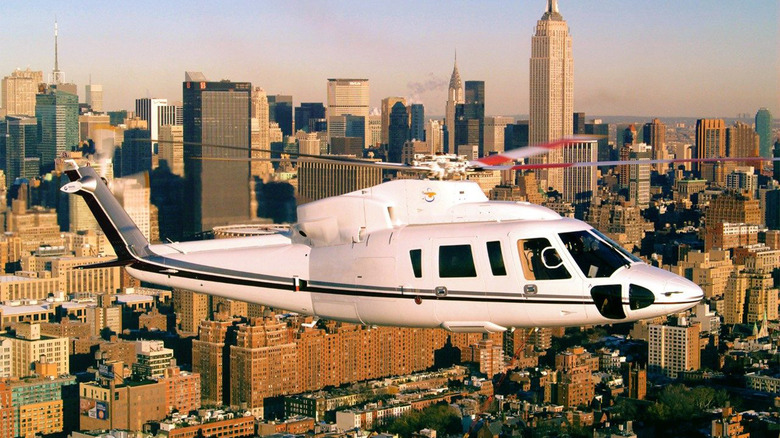
The Sikorsky S-76D is part of a proud tradition of good helicopters. The original S-76 had its maiden flight in the late 1970s and was officially released in the 1980s. Over the years, Lockheed Martin — which owns and builds Sikorsky helicopters — has made many changes and improvements, resulting in the release of the Sikorsky S-76D. This is the latest model of the long-running product line and received its FAA certification in 2012. It's marketed to executives and other wealthy folks as a transport helicopter for people, but has also been used in law enforcement, search and rescue, and emergency services.
Per Lockheed Martin, the maximum range on the Sikorsky S-76D is roughly 874 kilometers. That translates to 472 nautical miles or 543 regular miles. This is on the higher end of average, so we believe it to be a good place to start. The S-76D comes in several configurations, including a posh executive setup that includes your choice in cabinet materials, an electronically extended ladder, and acoustic treatments to reduce engine noise within the cabin. We're relatively sure that the law enforcement and EMS versions don't have those niceties, but it's still pretty neat.
All told, this fuel-sipping beast can carry up to 4,912 pounds and can seat eight people when fully decked out with seats. It's a solid overall helicopter that doesn't eat a lot of gas, and you can extend flying time by 30 minutes by adding extra tanks, but this does reduce overall range.
Airbus H160 (552 Miles)
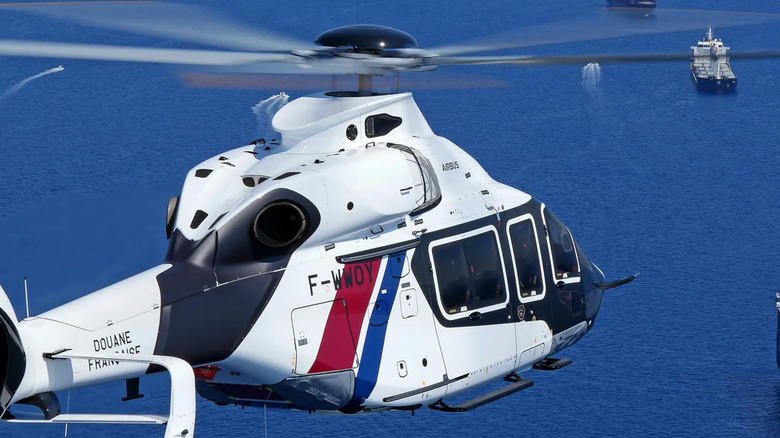
The Airbus H160 is one of four Airbus helicopters to make the list and one of the newer helicopters overall. It started shipping to customers in 2021, so outside of prototypes, there are no H160s older than four years old as of this writing. On top of being a decent helicopter, Airbus is also working on the H160M, a military variant that will go to countries like France. This helicopter is mostly marketed toward public service, like EMS and search and rescue, and has been built for those types of things.
In all, Airbus rates the H160 at 480 nautical miles, which translates to 552 miles, barely edging out the Sikorsky S-76D. Airbus claims it consumes 18% less fuel than competitors in the same class with the same style of engine. In fact, the company is pretty proud of this helicopter.
For other specs, the Airbus H160 is pretty decent overall. However, we'd also like to mention its larger sibling, the H175. It has a range of 600 nautical miles, which is a hair over 690 miles. It's a good addition to its civilian and military airplanes, making Airbus a good brand overall for air travel.
Airbus H225 And H215 (702 Miles And 771 Miles)
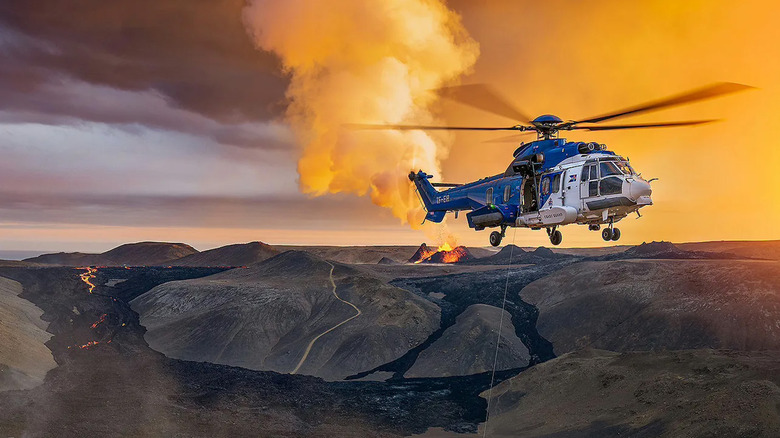
Airbus also has some real winners with the H225 and H215 helicopters. I wasn't kidding earlier when I said the whole list would be Airbus if we didn't combine some of these. Technically, the H225 is the larger of the two, and it's at the top of the Airbus' helicopter lineup. The H215 is designed for firefighting, law enforcement, aerial transport, and for aerial work. For the H225, Airbus says it's best suited for passenger transport and search and rescue, but both helicopters can be used for any civilian use case.
For range, the 200-series helicopters have much more than the 100-series. Despite being the higher-end model, the H225 actually gets less range, per Airbus. It'll go 1,130 kilometers. That's roughly 600 nautical miles or 702 regular miles. The H215 ups that figure to 1,241 kilometers, which is 670 nautical miles or about 771 regular miles. Surprisingly, the H215 gets its long range with just the standard fuel tanks, whereas the H225 needs extra fuel tanks to reach its maximum range. Thus, if you want full range, the H215 is the one to get.
The H215 can also carry more passengers (22 versus 19 on the H225). However, the H225 has an executive seating option for 11 so if you want to travel in style, the H225 is the way to go. Once again, we included both helicopters here to make room for other models, but the H225 and H215 belong on the list.
AugustaWestland AW139 (776 Miles)
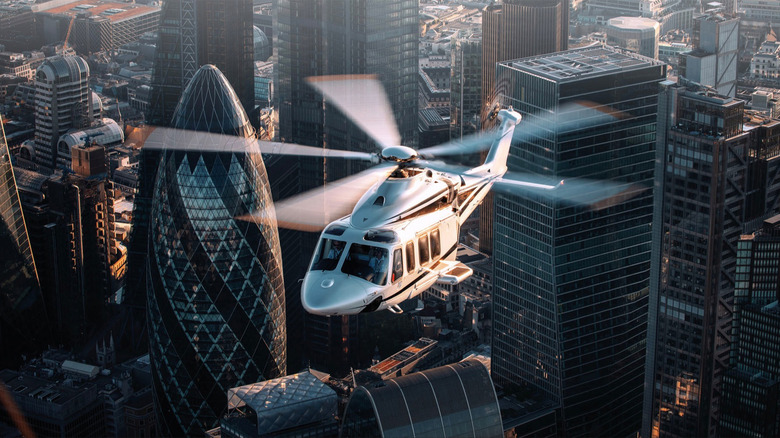
The AugustaWestland AW139 is a civilian helicopter made by Leonardo. In a weird scenario, AgustaWestland is owned by Leonardo, but the two companies produce under their respective names. You also may be more familiar with AgustaWestland's A129 attack helicopter. In any case, the AW139 is the longest-range helicopter we could find under the AugustaWestland brand. It's marketed mainly at VIP types, with five variations of the cabin that are all designed to carry passengers in luxury. However, if you search around the website, you can find brochures for the AW139 in law enforcement, search and rescue, and other utility purposes.
In terms of range, the AW139 has a range of 1,187 kilometers, or 641 nautical miles. That roughly translates to 737 miles, making the AW139 one of the best helicopters on the market for maximum range. That's for the VIP variant anyway. The search and rescue version boasts a 1,250-kilometer range, which is 675 nautical miles or about 776 miles. That puts it on par with the H200-series of offerings from Airbus. That's not bad for a helicopter costing over $6 million on the used market.
Unlike Airbus, the AW139 does range better than its larger counterpart, the AW189. That isn't usually the case when you step up in size. Even so, the AW189 still puts up 1,043 kilometers, or roughly 648 miles (563 nautical miles). Like with Airbus, we're including both here to shorten the list, but the AW189 would also qualify.
Leonardo AW609 (1,150 Miles)
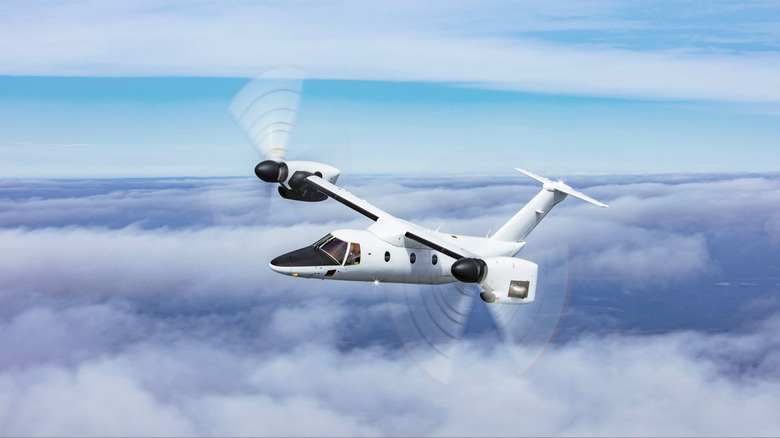
Technically speaking, the Leonardo AW609 doesn't exist yet. The first models went into production in 2022, and they're expected to be released sometime during or after 2025. Thus, we expect this helicopter to exist in the civilian segment sooner or later, and we wanted to include it to future-proof the list a little bit. You may notice that this doesn't look like a normal helicopter, and you'd be right. It's a tiltrotor, which mixes and matches the technology of an airplane with that of a helicopter. That means it can take off vertically like a helicopter by tilting its propellors and then flies forward by tilting them again like a prop plane.
This design has real advantages, and one of them is range. The AW609 boasts an incredible 1,852 kilometers of range. That's a cool 1,000 nautical miles or 1,150 miles, although Leonardo notes that you'll need the auxiliary fuel tank to achieve those numbers. It makes sense, though. After it takes off, it can fly forward like an airplane.
Once it does launch, Leonardo says it'll be available for all the same stuff as a normal helicopter, including search and rescue, EMS, executive transport, and more. However, I'd guess that it's probably going to cost a lot more than your standard helicopter.
The Longest Helicopter Flight Ever
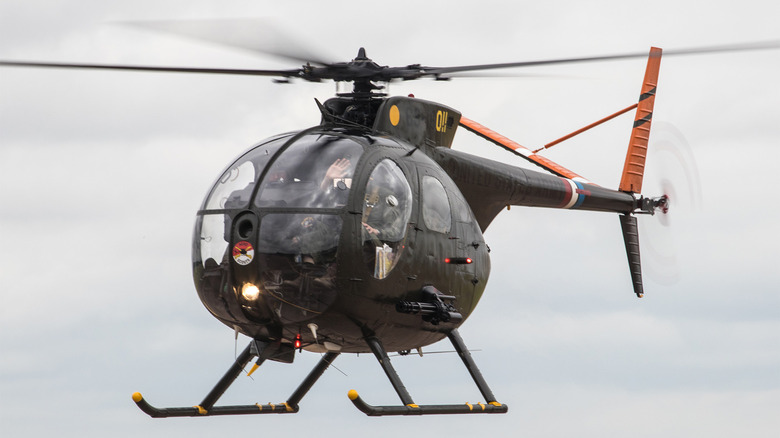
All of the ranges above are per the manufacturer's specifications, and those ranges will likely be attained under good conditions. However, a lot goes into range when you fly through the air. Winds can help or hinder depending on which way they blow, while things like altitude, speed, weight, fuel capacity, and other factors can impact things. This is personified no better than the longest helicopter flight on record. Per the Guinness Book of World Records, this was achieved in 1966 by Robert Ferry.
He was piloting a Hughes YOH-6A at the time. This little guy was rated for about 380 miles at 5,000 feet. Ferry flew from Culver City, California to Ormond Beach, Florida without stopping to refuel. The overall distance is recorded as 3,561.6 kilometers, or 2,213.1 miles. Not a ton is known about how he did it, but it's pretty well established that the YOH-6A was decent fuel capacity for its size and the pilot engaged in every conceivable fuel-saving measure he could think to do, including increasing or decreasing his altitude to make use of tail winds and flying at lower RPMs. He also had no autopilot, meaning he was in full control for the entire flight.
You can read the story of his experience here. The lesson is that if you know how to fly with fuel efficiency in mind, you can sometimes go further than the rated fuel range.
Want the latest in tech and auto trends? Subscribe to our free newsletter for the latest headlines, expert guides, and how-to tips, one email at a time.
Read the original article on SlashGear.













